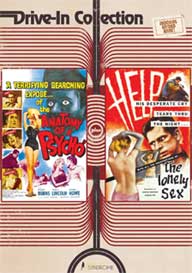 DRIVE-IN
COLLECTION: ANATOMY OF A PSYCHO (1961)/THE
LONEY SEX (1959)
DRIVE-IN
COLLECTION: ANATOMY OF A PSYCHO (1961)/THE
LONEY SEX (1959)Directors: Boris Petroff (as Brooke L. Peters)/ Richard Hilliard
Vinegar Syndrome
 DRIVE-IN
COLLECTION: ANATOMY OF A PSYCHO (1961)/THE
LONEY SEX (1959)
DRIVE-IN
COLLECTION: ANATOMY OF A PSYCHO (1961)/THE
LONEY SEX (1959)Vinegar Syndrome’s Drive-In Collection line gives the remastered treatment to two long overlooked PD-staples: the Ronnie Burns vehicle ANATOMY OF A PSYCHO and the proto-roughie THE LONELY SEX.
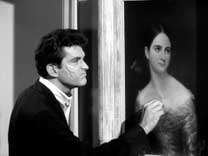
On the night of his revered brother Duke’s execution for a stick-up murder, Chet (Darrell Howe) snaps and decides to get even with everyone responsible for the conviction with the help of his four buddies including ex-Marine Moe (Don Devlin, BLOOD OF DRACULA) and impressionable Bobbie (Frank Killmond). His exploits escalate from beating the district attorney’s son to torching the home of the judge when invited to a party by his son (Pat McMahon) who doubly incurs Chet’s ire by dating his social-climbing girlfriend Sandy (Judy Howard, GHOST OF DRAGSTRIP HOLLOW). When Mickey (Ronnie Burns) –fiancé of Chet’s sister Pat (Pamela Lincoln, THE TINGLER) – decides he must tell the siblings that his father Frank (Russ Bender, IT CONQUERED THE WORLD!) was the prosecution’s eye witness in the case against Duke, Chet goes off the deep end but Mickey is the one who finds himself in trouble with the law when he accidentally stabs Moe in a struggle.
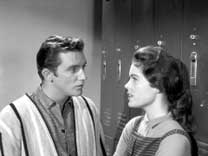 Resurrected
on VHS by the likes of Sinister Cinema and Something Weird Video, Boris Petroff’s
ANATOMY OF A PSYCHO became a PD staple in the early days of DVD starting with
a Madacy double bill with an equally unauthorized HATCHET FOR THE HONEYMOON
(having made the rounds on many a VHS label in the 1980s). Despite the title,
it’s not really a good fit with the Bava film. Petroff’s film is
more of a noir/JD/courtroom drama hybrid that seems more like an episode of
a 1960s TV crime show than a feature film. It’s easy to see why this one
fell into the cracks as it seems unable to decide if it wants to indeed be an
“anatomy of a psycho” or a star vehicle for first-billed Burns,
who was an entertaining addition to his parents’ show THE GEORGE BURNS
AND GRACIE ALLEN SHOW giving his mother more comical opportunities to try to
deceive her husband, but kind of a dull romantic lead here (and overshadowed
both by love interest Lincoln and scenery-chewing Howe). While Howe often goes
hilariously over-the-top in his scenes of psychosis, his character ends up being
a pitiable figure (despite trying to send an innocent man to the gas chamber);
and viewer sympathy may indeed be meant to lie with him in his contempt for
the haves (even if his primary motivation against them is revenge).
Resurrected
on VHS by the likes of Sinister Cinema and Something Weird Video, Boris Petroff’s
ANATOMY OF A PSYCHO became a PD staple in the early days of DVD starting with
a Madacy double bill with an equally unauthorized HATCHET FOR THE HONEYMOON
(having made the rounds on many a VHS label in the 1980s). Despite the title,
it’s not really a good fit with the Bava film. Petroff’s film is
more of a noir/JD/courtroom drama hybrid that seems more like an episode of
a 1960s TV crime show than a feature film. It’s easy to see why this one
fell into the cracks as it seems unable to decide if it wants to indeed be an
“anatomy of a psycho” or a star vehicle for first-billed Burns,
who was an entertaining addition to his parents’ show THE GEORGE BURNS
AND GRACIE ALLEN SHOW giving his mother more comical opportunities to try to
deceive her husband, but kind of a dull romantic lead here (and overshadowed
both by love interest Lincoln and scenery-chewing Howe). While Howe often goes
hilariously over-the-top in his scenes of psychosis, his character ends up being
a pitiable figure (despite trying to send an innocent man to the gas chamber);
and viewer sympathy may indeed be meant to lie with him in his contempt for
the haves (even if his primary motivation against them is revenge).
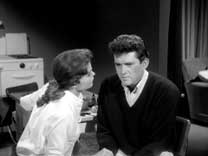
The film stumbles with him during the trial sequence in which the defense attorney (Robert Stabler) vows to Mickey’s father to keep Chet on the stand for a week if that’s what it takes to get him to crack, only to give up after one session; however, this does allow the film to get to the climax closer (and it does not end the way you think it will). Michael Granger (CREATURE WITH THE ATOM BRAIN) skulks around as a police lieutenant who suspects Chet and his gang and employs psychological tactics to try to get them to slip up (particularly seeming weak link Bobbie), and his actions during the climax are unexpected. ANATOMY OF A PSYCHO was the last film role for Devlin, father of writer Dean Devlin (INDEPENDENCE DAY). He co-scripted the film with Jane Mann (who wrote director Petroff’s earlier THE UNEARTHLY) and would later become produce films like LOVING, MY BODYGUARD, and THE WITCHES OF EASTWICK before his death in 2000. The monochrome cinematography of Joel Colman (BIG TIME) is mostly bland, but he does manage some nice hard lighting during the night exteriors; the two striking stock shots inside the prison when Chet goes to visit his brother, however, appear to date back at least as far as 1956’s INDESTRUCTIBLE MAN with Lon Chaney Jr.
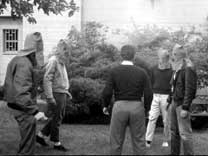 ANATOMY
OF A PSYCHO has been given a new fullscreen (1.33:1) transfer from a 2K scan
of a largely unblemished source apart from the reel changes and a couple scarred
passages (the closing credits seem to have come from an inferior source). The
Dolby Digital 2.0 mono track is generally fine, although the track of course
exhibits damage in the same spots as the print. The increased clarity does no
favors for Howe’s scar make-up (not only is it more apparent as an appliance,
but it makes him look less like a “bad boy” and more like he’s
got an infection), and it tends to lend much of the film’s interior scenes
a TV production feel. As with Vinegar Syndrome’s other titles, the chapters
are divided up into reels (of which there are four for this feature).
ANATOMY
OF A PSYCHO has been given a new fullscreen (1.33:1) transfer from a 2K scan
of a largely unblemished source apart from the reel changes and a couple scarred
passages (the closing credits seem to have come from an inferior source). The
Dolby Digital 2.0 mono track is generally fine, although the track of course
exhibits damage in the same spots as the print. The increased clarity does no
favors for Howe’s scar make-up (not only is it more apparent as an appliance,
but it makes him look less like a “bad boy” and more like he’s
got an infection), and it tends to lend much of the film’s interior scenes
a TV production feel. As with Vinegar Syndrome’s other titles, the chapters
are divided up into reels (of which there are four for this feature).
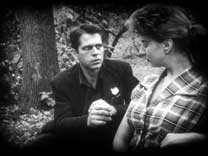
THE LONELY SEX proves to be a more appropriate co-feature to ANATOMY OF A PSYCHO than HATCHET FOR THE HONEYMOON, although not by much. Barely an hour long, THE LONELY SEX tells the story of a loner (Karl Light) living in a shack in a quarry. The loner loses his nerve whenever he tries to talk to women and is reduced to peeking in store windows at mannequins in lingerie. He becomes obsessed with Annabelle (Jean Evans) when he finds a Polaroid in the woods of her taken by her boyfriend (Carl Collyer). When he comes upon Annabelle in person, he tries to approach her but she runs, tripping and knocking herself out on a rock. He takes her back to his shack and imprisons her, but is he really the one behind the recent slayings of young women in the nearby Memorial Park?
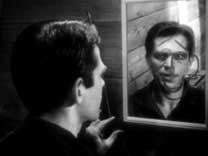 With
some daring nudity for a 1959 film – a lingering shot of a peeping tom
victim that might have been added later – THE LONELY SEX almost seems
like a very early roughie film like those that Michael and Roberta Findlay and
the like would start helming just a few years later. Director Richard Hilliard
is better known for his collaborations with Del Tenney (cinematographer on CURSE
OF THE LIVING CORPSE, writer/cinematographer of HORROR OF PARTY BEACH, and writer/director
of VIOLENT MIDNIGHT/PSYCHOMANIA), but he would contribute his own entry into
the roughie subgenre with the once-thought-lost I, MARQUIS DE SADE (1967, review
forthcoming). The loner’s entire stalking, capturing, and killing of his
possibly first onscreen victim (pin-up Jackie Miller who followed this film
up with two of Joseph Mawra’s OLGA films) is photographed with a vignette
darkening all four sides of the frame almost like a silent film with exaggerated
performances by both performers (and post-dubbed laughter and gasps), but it
could also almost pass for something shot by the Findlays a few years later
(minus nudity and chocolate syrup blood). The film was released theatrically
by Joseph Brenner who started his distribution company in the mid-1950s and
would last throughout the 1980s (American Eurocult readers have him to thank
for importing TORSO, EYEBALL, ALMOST HUMAN, AUTOPSY, THE MAN FROM DEEP RIVER,
and more in the 1970s).
With
some daring nudity for a 1959 film – a lingering shot of a peeping tom
victim that might have been added later – THE LONELY SEX almost seems
like a very early roughie film like those that Michael and Roberta Findlay and
the like would start helming just a few years later. Director Richard Hilliard
is better known for his collaborations with Del Tenney (cinematographer on CURSE
OF THE LIVING CORPSE, writer/cinematographer of HORROR OF PARTY BEACH, and writer/director
of VIOLENT MIDNIGHT/PSYCHOMANIA), but he would contribute his own entry into
the roughie subgenre with the once-thought-lost I, MARQUIS DE SADE (1967, review
forthcoming). The loner’s entire stalking, capturing, and killing of his
possibly first onscreen victim (pin-up Jackie Miller who followed this film
up with two of Joseph Mawra’s OLGA films) is photographed with a vignette
darkening all four sides of the frame almost like a silent film with exaggerated
performances by both performers (and post-dubbed laughter and gasps), but it
could also almost pass for something shot by the Findlays a few years later
(minus nudity and chocolate syrup blood). The film was released theatrically
by Joseph Brenner who started his distribution company in the mid-1950s and
would last throughout the 1980s (American Eurocult readers have him to thank
for importing TORSO, EYEBALL, ALMOST HUMAN, AUTOPSY, THE MAN FROM DEEP RIVER,
and more in the 1970s).
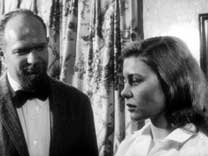
Predating PSYCHO, the film is sympathetic to its loner protagonist (this may not be the wrong word since he’s the only character with any depth), not condoning his crimes but recognizing them as a cry for help (literally in the loner’s case). The film is also less clinical in the way it views the character through the eyes of others; Annabelle’s father (Richard Nicholls) not only expresses a need to understand and help troubled individuals; he also points out that those who are the loudest in their condemnations are usually trying to cover up something up.
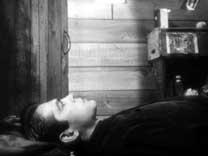 The
doctor’s portly friend Wyler is one of the latter as he is introduced
spying on a woman through her bedroom window while she is changing, and later
trying to catch Martha (Mary Gonzalez) – the daughter of his boardinghouse
landlord – changing clothes on more than one occasion by mistaking her
room for his (he’s also the one who says the killer should be hunted down
and destroyed). Through an attempted pick up of an older woman at a bar and
a visit by the loner to his married sister Mary (Peggy Allison), we are made
privy to details of the loner’s past including a failed sexual initiation,
a history of peeping, and his sister badgering him to just pick up a hooker
and be done with it. He is tempted to “confess” his sins at a local
church but can’t bring himself to cross the threshold; but he finally
does attempt to get help from Annabelle’s father (having discovered the
man’s card in her address book), but that decision proves unfortunate
due to Wyler’s need to cover up his own proclivities with self-righteous
anger. Ultimately the film isn’t pro-sex criminal, but an examination
of the ways in which marginalized people function (or not) in a world where
sexual dysfunctions are considered perversions, and the ending is wonderfully
cynical.
The
doctor’s portly friend Wyler is one of the latter as he is introduced
spying on a woman through her bedroom window while she is changing, and later
trying to catch Martha (Mary Gonzalez) – the daughter of his boardinghouse
landlord – changing clothes on more than one occasion by mistaking her
room for his (he’s also the one who says the killer should be hunted down
and destroyed). Through an attempted pick up of an older woman at a bar and
a visit by the loner to his married sister Mary (Peggy Allison), we are made
privy to details of the loner’s past including a failed sexual initiation,
a history of peeping, and his sister badgering him to just pick up a hooker
and be done with it. He is tempted to “confess” his sins at a local
church but can’t bring himself to cross the threshold; but he finally
does attempt to get help from Annabelle’s father (having discovered the
man’s card in her address book), but that decision proves unfortunate
due to Wyler’s need to cover up his own proclivities with self-righteous
anger. Ultimately the film isn’t pro-sex criminal, but an examination
of the ways in which marginalized people function (or not) in a world where
sexual dysfunctions are considered perversions, and the ending is wonderfully
cynical.
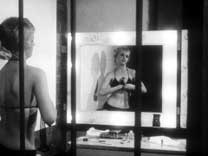 Like
ANATOMY OF A PSYCHO, the fullscreen, less-than-pristine source element for THE
LONELY SEX has been treated to a new 2K high definition scan. The source is
not pristine, but the treatment is admirable. The Dolby Digital 2.0 rendering
of the mono audio is generally fine (some dialogue can sound tinny, but that
may be the original mix since the music during those bits sounds okay). Since
the film’s chapters are divided by reels, there are only three for the
58-minute running time. There are no extras. ANATOMY OF A PSYCHO and THE LONELY
SEX are not the most exciting titles in their Drive-In Collection line so far;
however, their respectful treatment of the pair offers a chance to assess a
pair of films that may have gone unseen by appreciative viewers due to their
ubiquity on the PD tape and disc market. (Eric
Cotenas)
Like
ANATOMY OF A PSYCHO, the fullscreen, less-than-pristine source element for THE
LONELY SEX has been treated to a new 2K high definition scan. The source is
not pristine, but the treatment is admirable. The Dolby Digital 2.0 rendering
of the mono audio is generally fine (some dialogue can sound tinny, but that
may be the original mix since the music during those bits sounds okay). Since
the film’s chapters are divided by reels, there are only three for the
58-minute running time. There are no extras. ANATOMY OF A PSYCHO and THE LONELY
SEX are not the most exciting titles in their Drive-In Collection line so far;
however, their respectful treatment of the pair offers a chance to assess a
pair of films that may have gone unseen by appreciative viewers due to their
ubiquity on the PD tape and disc market. (Eric
Cotenas)